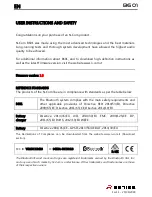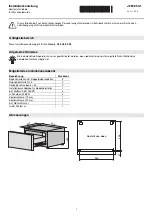
6
5.
IMPACT OR CRUSH HAZARD.
Do
NOT
over-tighten fasteners. Applying too
much torque may cause fasteners/threads to
fail, and could allow product to collapse. Failure
to obey this warning could result in death or seri-
ous injury.
ALWAYS
use sealant on (clean)
parts and surfaces where fasteners enter RV’s
[walls / roof / floor]. Otherwise, water leakage
could occur.
Apply sealant along entire top edge of mount-
ing bracket (where it contacts RV’s wall), and
around drilled holes. Then place and tighten car-
riage bolts (with locknuts, and washers) through
mounting bracket and drilled holes in RV wall.
See (FIG. 4) & (FIG. 8).
Tighten to 35 ±5 in·lb torque.
If solid structure is
NOT
present, use
backing plates and sleeves. See (FIG. 5).
Alternative fasteners may be used only if
size and strength requirements are met for
safe installation and operation of awning.
Bolt head
MUST
be no taller than 1/8″.
See subsection, “A. Determine Awning
Location” on page (5) for more fasten-
er and wall thickness requirements.
Sealant
FIG. 8
B. Install Mounting Bracket
1.
Install mounting bracket(s) on a
flat surface, and level to ensure correct function
and appearance.
Using the mounting bracket as a template, mark
its position and all hole locations. See (FIG. 2).
2. Mark a line between the (2) outside top holes,
and between the (2) outside bottom holes. See
(FIG. 7).
FIG. 7
Horizontal Line
Between Outside
Bottom Holes
Horizontal Line
Between Outside
Top Holes
Vertical
(Intersecting)
Line
3. Verify horizontal lines are level. Then mark ver-
tical lines from all remaining holes to intersect
marked horizontal lines. See (FIG. 7).
Due to the nature of long extruded parts,
the mounting bracket may be slightly
bowed. Some hole locations may be
above or below marked horizontal lines.
4.
FIRE OR ELECTRICAL SHOCK
HAZARD. Make sure there are no obstacles
(wires, pipes, etc.) inside RV’s [roof / floor /
walls]. Shut
OFF
gas supply, disconnect 120
Vac power from RV, and disconnect positive (+)
12 Vdc terminal from supply battery
BEFORE
drilling or cutting into RV. Failure to obey these
warnings could result in death or serious injury.
Drill 1/4″ clearance holes for M6 carriage bolts
on the marked (intersecting) locations. See
(FIG. 2) & (FIG. 7).
If sleeves (installer supplied) are used,
larger clearance holes are necessary. Drill
appropriately sized clearance holes to ac-
commodate sleeves.
INSTALLATION




























